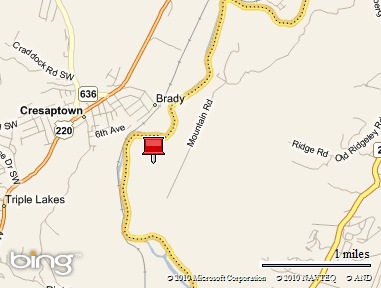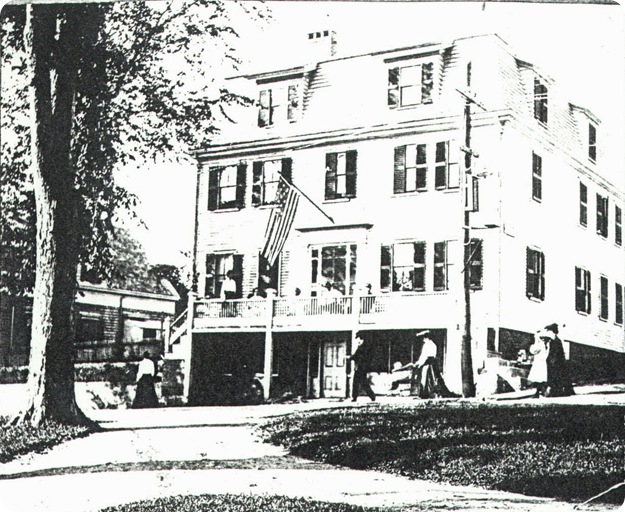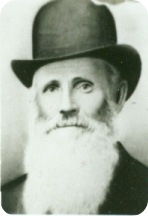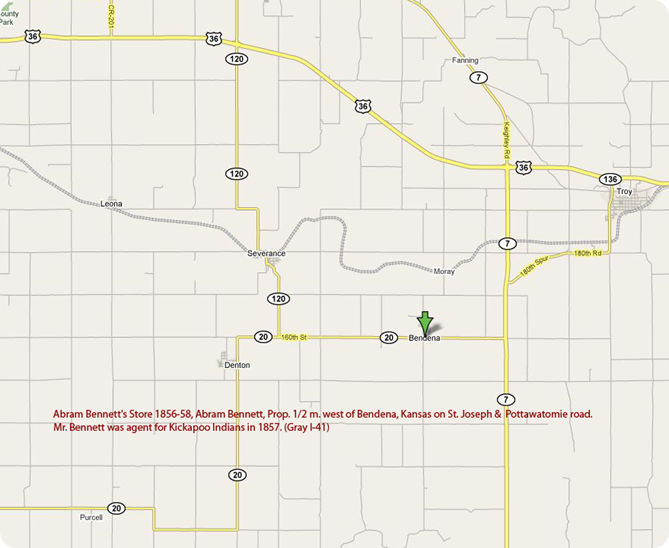My 6th great grandfather, Colonel William Anderson, was not only a brave man, but also personified the descriptive word “Character”.
Born in Scotland prior to 1700, William was an adherent of Prince James, son of James II. After supporting the insurrection of 1715, he was forced to flee the country in disguise to Virginia. He eventually settled on the North Branch of the Potomac River in what is now Hampshire Co., West Virginia in a beautiful valley known to this day as the "Anderson’s Bottom".
Family stories state that his family shipped him a small trunk full of gold after hearing that he had safely arrived in America. He used some of that wealth to purchase multiple properties in Maryland and Virginia. The stories state that the remaining gold was still buried on his property at Anderson’s Bottom at the time of his death at age 104 in 1797.William married Rachel Mary Lauren, a Scottish born beauty in 1732 in Hampshire Co., Virginia. The couple had four daughters and two sons, two of which, Catherine and Thomas are my direct ancestors.
Early in his adult life, George Washington was a surveyor who frequently stopped by the the Anderson home overnight for lodging, a meal and a visit with his old friends. The friendship continued on through the years and the Anderson’s were called up to defend the area from Indian raids prior to the Revolutionary War and against British-backed Indian raids during the war and the subsequent years thereafter. William Anderson Jr. was killed by Indians while still in his youth, a hard blow to the family who lived so deep in to Indiana territory.
Colonel William and his surviving son, Thomas, joined Braddock's forces at Cumberland and served during the western campaign. Col. William, so it is stated, always wore Scots dress.
William Anderson was found as a Private listed in Captain William Preston's Company of Rangers from 8 Jun 1757 - 4 May 1759 as authorized by an Act of the House of Burgesses.
William was a member of the Protestant Episcopal Church. He owned in 1738, and prior thereto, several plantations in the Conegochiege manor, in Prince Georges's County, Maryland, one of which called Anderson's Delight, he sold to Dr. George Stewart of the city of Annapolis in 1739.
Jim Burrows has posted an excellent research and documentation about the life and properties of William Anderson on his Anderson Papers site that I highly recommend to researchers and other Anderson descendants.
Additionally, another Anderson descendant, John Phillips, has written a historical fiction book about the life and times of William Anderson titled “Anderson’s Bottom”
From the book: Life and Letters of Judge Thomas J. Anderson and Wife:
"William Anderson of Scotland, descended from a family of considerable prominence, born in the Highlands in 1693, implicated in the rising of 1715 in behalf of the Pretender, Prince James, son of James II, fled in disguise, after the cruel suppression of this incipient rebellion, through England to Virginia, where British loyalists of his views ever found a warm welcome."
Marion, Ohio, Oct. 26, 1886.
Mr. J. H. Anderson, Columbus, Ohio.
My Dear Nephew:--
I now undertake to give you some account of my ancestors. My Great-grandfather, William Anderson, was born in Scotland, in the year 1693 and died in Virginia in 1797. He was a friend of the Stuart dynasty, and joined the standard of Prince James, the Pretender, (as he was styled by some) son of James II, the deposed King of England.
After the rising in 1715, he fled into England where he tarried awhile, and then made his way in disguise, I am told, to Virginia, where he had relatives. He went up the Potomac river till he came to a beautiful and fertile valley, or bottom, on the North Branch, and here he decided to settle. It has ever since been called the Anderson Bottom, and was afterward included within the boundaries of Hampshire County, Virginia. That was then a wild region, inhabited mainly by Indians, but there were a few French, and probably a few British subjects west of William Anderson's new home.
He was strong and brave, and helped to protect the frontier settlements from murderous Indian foes. In "Braddock's defeat" (Braddock's engagement with the French and Indians near Fort Duquense) though beaten he fought bravely.
He was the father of four children, two boys and two girls. One of his sons, William, was killed by the Indians in the mountains near home. One of his daughters married Captain William Henshaw, of Berkley County, Virginia, whose plantation was near Bunker Hill, on Mill Creek.
I have forgotten the name of the husband of the other daughter, although I have often heard it. (In a subsequent letter he says her name was Sarah and that she married a Mr. Wilkins.)
As he, William Anderson, was 104 years old at the time of his death he was a little childish, but at 80 he was as strong and active as ever. He brought a large amount of gold from Scotland, or it was afterward sent to him, and he was known to possess a great deal when he died, but after his death it could never be found.”
(Source: Life and letters of Judge Thomas J. Anderson and wife, including a few letters from children and others : mostly written during the civil war; a history by James House Anderson.)
From the now defunct Silver Family Organization website:
"He (William) owned in 1738 and prior thereto several plantations in the Conegochiege Manor in Prince George's County, Maryland, one of which, called Anderson's Delight, he sold to Dr. George Stewart of the city of Annapolis in 1739. It was soon after coming to the country that a rich and beautiful valley, far up the Potomac on the North Branch attracted his notice and on it he encamped and buit a hunting lodge. This valley has ever since been known as the Anderson Bottom. When Hampshire County, Virginia, was erected, it embraced the Anderson Bottom, which was only five miles from Fort Cumberland, constructed in 1754. William Anderson died on the Anderson Bottom in Hampshire County, Virginia."
WILLIAM ANDERSON’S WILL
Hampshire County, West Virginia
Made 10 September 1786
Proved 9 April 1796
Hampshire County Wills; Box 1-200; #18
In the Name of God Amen. I, William Anderson of Hampshire County and State of Virginia, farmer, being very weak in body but of perfect mind memory and understanding, and Mindful of my Mortality, do this Tenth day of September in the Year of our Lord one Thousand Seven hundred and Eighty Six, Make and publish this my last Will and (?testament) in the (?manner) following. First, I resign my Soul into the hands of Almighty God, hoping and believing a Remission of my Sins by the merits and mediation of Jesus Christ and my Body I commit to the Earth and desire to be decently and privately Buried at the discretion of my Executor and my Worldly Estate I give and devise as follows--
First, I give and bequeath to my Dear Beloved Wife all my Moveable or Personal Estate--Consisting of one Horse, Cows, Calves, and Hogs, to her and for her own proper use forever--also all my household Furniture to her forever, also I give and bequeath to her for and during her Natural Life, my now dwelling house, out houses and all there appurtenances (?therewith) belonging . One half of the Orchards and its profits, my Lower Meadow and one Field adjoining my Upper Meadow Containing Ten acres of Tillable Land to and for her own use during her Natural Life.
Next, I give and bequeath unto my five Daughters, Namely, Nancy, Rachel, Sarah, Catherine and Hannah, Each One Shilling Sterling. And Lastly, I Constitute Ordain make and appoint My Only Son Thomas Anderson my Sole Executor of this my Last Will and Testament all and Singular my Lands, Messuages and Tenements by him to be possessed and any (?--indecipherable lines) before to me (?--indecipherable) --Revoke and Disannull all and every other (?f----) and Bequests whatsoever by me in any Ways before bequeathed, Ratifying and Confirming this and no other to be my Last Will and Testament in Witness whereof I have hereunto set my hand and Seal the day and Year before written---(?__illegible)
(signed by mark) William X Anderson
(----)
declared by the Testator and for his last Will and Testament, in the
presence of us, who, at his request in his presence and in the presence of each other have Subscribed our Names
as Witnesses thereto--
Evan Gwynnes
Henry Hains
Arthur (?___) Ohara
Attached document was Recorded and Examined and
(Recorded in) Will Book 1-22; Page 26
At a Court held for Hampshire County the 9th day of April 1796.
This the last Will and Testament of William Anderson deceased was proved by the Oath of Arthur OHarra one of the Witnesses thereto and on the (?Motion) of Thomas Anderson the Executor therein named certificate is granted him for obtaining aprobate thereof in due (?form) he having taken the Oath of (?___ Executor and together with Arthur O'Harra and John House his Securities entered into and Acknowledged a Bond in the penalty of three hundred pounds Conditioned as the Law directs And at a Court held for the said County the 11th day of June (?three weeks) following the said Will was further proved by the Oath of Evan Gwynies another Witness thereto and is ordered to be Recorded
Test--
AudWodrow
Support provided by William Anderson to the Revolutionary War per Publick Claims:
Wm. Anderson for provisions & forage for cattle drivers £1-5-7.
William Anderson 86# flour 8s-7.
This surname, meaning 'son of Andrew', is prolific, being common in Lowland areas as well as in the north-east. The reason why this name arises in so many different locations is due to Scotland's patronymic system and little can be shown to suggest descent from a common ancestor. Thirteenth-century records give the earliest instances of the name and by the sixteenth and seventeenth centuries, several burghs were represented in parliament by Andersons. The Furman-Workman MS of 1566 includes arms for Anderson of that ilk, implying that a notable Anderson was recorded as representer of the clan, but identification has never been established. In Privy Council records (James Y 2nd April 1526), one James Anderson of Sterheuch was made Carrick Pursuivant of Arms and in this position at the Court of the Lord Lyon, not to have borne and used arms is hard to reconcile. It has been suggested that he, and Anderson of that Ilk, were one and the same. This James is claimed as ancestor o the Anderson of North family in Strathbogle, yet the present senior line remains unknown. In more recent times their crest of an oak tree Proper with the motto 'Stand Sure', has been tacitly accepted by the Andersons as their clansman's crest badge. A Clan Anderson Society has been active for some years in North America and St Andrew's Day. 1993 saw the foundation of The Anderson Association in the United Kingdom.
Letter from Hiram H. Anderson to his nephew, James H. Anderson: "I do no know all the plantations my great-grandfather William Anderson owned, but I know he was vastly rich. He was married twice. His second wife, a Miss Barnett, wa a girl of seventeen, with whom he lived twenty-four years. At the time of his second marriage he was 80 years old. When he died he was 104, and his wife died the following year. I believe he had no children by the second marriage." "My great-great-grandfather William Anderson, acquired the Anderson Bottom plantation in Hampshire county Va., by patent from Thomas, Lord Fairfax. Besides his Maryland real estate, William owned a number of other tracts. William and his (first) wife Rachel, conveyed 100 acres of good land on new Creek, in Hampshire county, to John Baker, Nov. 9, 1772. William and his (second) wife Margaret conved Sept. 17, 1787, to James Malloy, 327 acres of choice land, situate on Gibbons and Crooked runin in said county. Thomas Anderson and Sarah his wife, conveyed Nov. 22, 1802, said 206 acres to Martin Shaffer. Thomas Anderson conveyed April 16, 1802, by deed of gift, 93 acres of the Anderson Bottom to his son James. Thomas Anderson conveyed Feb. 26, 1806, to Daniel Collins, all the Anderson Bottom land except said 93 acres. James Anderson and Priscilla his wife, conveyed February 26, 1806, to Daniel Collins said 93 acres. The deeds of conveyance and of said real estate, except of the Maryland property, are all of record in Romney, Hampshire county, W. Va. William Anderson obtained the most of his Virginia real estate from Lord Fairfax."
(Source: Life and letters of Judge Thomas J. Anderson and wife, including a few letters from children and others : mostly written during the civil war; a history by James House Anderson.)
William Anderson of Scotland descended from a family of prominence, born in the Highlands in 1693, implicated in the rising of 1715 in the behalf of the pretender, Prince James, son of James II., fled in disguise, after the cruel suppression of this incipient rebellion, through England to Virginia where British loyalties of his views ever found a warm welcome; it was not long after his arrival in Virginia until he received remittances with which he bought real property in Maryland and Virginia. He owned in 1738 and prior thereto several plantations in the Conegochiege Manor in Prince George's county, Maryland, one of which, called Anderson's Delight, he sold to Dr. George Stewart of the city of Annapolis in 1739. It was soon after coming to the country that a rich and beautiful valley, far up the Potomac, on the North Branch, attracted his notice and on it he encamped and built a hunting lodge. This valley has ever since been known as the Anderson Bottom. When Hampshire county, Virginia, was erected, it embraced the Anderson Bottom, which was only five miles from Fort Cumberland, constructed in 1754. William Anderson died on the Anderson Bottom in Hampshire county, Virginia."
From Electric Scotland
http://www.electricscotland.com/webclans/atoc/ander2.html
Anderson
The name Anderson meaning "son of Andrew" although widespread in Scotland is also found in Europe particularly in Scandinavia. In the Highlands the form MacAndrew is more commonly found and this family is thought to be connected with the Clan Anrias, a sept of Clan Ross who were also associated with the Clan Chattan federation from the beginning of the 15th century. In the Kinrara manuscript it is claimed that the MacAndrews came to Badenoch from Moidart about 1400. The first recording of this name appears on the Ragman Rolls of 1296 when David le fiz Andreu, Burgess of Peebles, and Duncan fiz Andreu of Dumfries were among those to swear allegiance to Edward I. One famous member of the family was John MacAndrew of Dalnahatnich - Iain Beg MacAindrea, Little John MacAndrew, a bowman of note and terror of all who fought against him; the family is, however, more renowned for its members' intellectual achievements. Aberdeen born Alexander Anderson was acclaimed as a brilliant mathematician in Europe when he published his works on geometry and algebra in Paris between 1612 and 1619. His cousin David Anderson of Finshaugh also had a fine mathematical brain and was known locally as "Davie-do-a'-things"; his best known achievement was to devise a method of removing a large rock which had been blocking the entrance to Aberdeen harbour. The family talent was passed on to a grandson, James Gregory, the inventor of the Reflecting Telescope. A later generation included James Anderson (1739-1808 ); his article on monsoons, for the first edition of the "Encyclopaedia Britannica" predicted, with remarkable accuracy, discoveries made by Captain Cook before he had returned from his expedition to announce them! Prominent Anderson families are Andersons of Dowhill, Wester Ardbreck in Banffshire and Candacraig in Strathdon. Arms were awarded in the 16th century to Anderson of that Ilk, but his family has not yet been identified as the leading family and as a result, the main house is considered to be that of Ardbreck.
ANDERSON or ANDREWSON simply means son of Andrew, and it must be understood that the prevalence of this surname throughout Scotland supposes that Andrew was early adopted as a popular Christian name - probably due to St. Andrew being our patron saint. Consequently, many families of quite differing origins now bear the name. Anderson is also a Lowland rendering of the old Gaelic personal name Gillaindreis (servant/devotee of (St) Andrew), and MacGillandreis is of like origin. The Clan Ross are sometimes called Clann Aindrea (the race of Andrew), and Gillanders, as a surname, is often equated with Ross, being a frequently found amongst the early Ross', whose descent was from Fearchar Mac-an-t-Sagairt, a Hereditary Abbot of Applecross. Early in the 15th century, another family, the Clan Andrish, natives of Moidart (not far from Applecross), reputedly founded by a Donald MacGillandrish, settled at Connage in Petty, and became embodied into the Confederation of Clan Chattan, under its Mackintosh Chief. In course of time their name was anglicized as MacAndrew. Though the Andersons are sometimes given as a sept of Clan Ross the idea that all are of Highland origin and share a common ancestry is quite absurd. NO clan connection should be assumed without additional evidence and such may be acquired through a compilation of one's personal ancestry. Many Andersons who trace an ancestry to Islay were once Macillandrais' who anglicised their name. In its present form the name is common in Aberdeenshire where we find the Andersons of Downhill, and of Candacraig in Strathdon, whereas, in Banffshire, the Andersons of Wester Ardbreck are long established. It should also be remembered that the name is also common outwith our shores, particularly in Scandinavia, and Andersons settled furth of Scotland should look to their ancestry before claiming Scottish descent, far less clan association.
Agnes (Anderson) Henshaw was a daughter of William Anderson, a Scotchman of good family, of property, and education. In his native country he stood by the Stuarts, an in 1715 befriended and fought for Prince James. Then he was forced to fly, and after wandering about England for some months, he continued to reach Virginia, where he found many people of his way of being relatives, and a permanent home. Very soon after his arrival in Virginia, he became the owner of a farm that has ever since been known as the "Anderson Bottom". It is on the North Branch of the Potomac in Hampshire County, that was afterward formed, embracing this place. Fort Cumberland, five miles distance, was erected a good many years after Col. William Anderson's occupation of the bottom.
This region was then for the most part a howling wilderness, and savage Indians were the principal human inhabitants. William Anderson was a soldier by nature, and brave, and in his efforts to protect the infant frontier settlements had many conflicts with the Indians. He and his son Thomas joined Braddock's forces at Fort Cumberland, on their way to Fort Duquesne, near which they were destined to suffer a disastrous defeat. Col. William Anderson was somewhat eccentric with all his noble qualities. He always wore a Scotch style of dress; and when he died in 1797, at the age of 104, his heavy head of hair was perfectly black, his teeth sound and white and his eyesight as good as ever, so that he read without glasses.























 Franklin Wheeler Young
Franklin Wheeler Young
 Thomas Ashton
Thomas Ashton